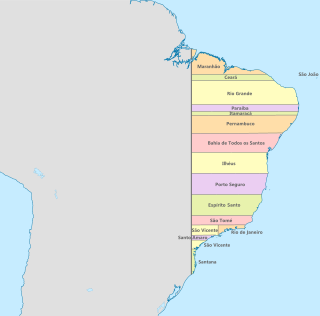Related Research Articles

Brazil, officially the Federative Republic of Brazil, is the largest country in South America and in Latin America. At 8.5 million square kilometers (3,300,000 sq mi) and with over 217 million people, Brazil is the world's fifth-largest country by area and the seventh most populous. Its capital is Brasília, and its most populous city is São Paulo. The federation is composed of the union of the 26 states and the Federal District. It is the only country in the Americas to have Portuguese as an official language. It is one of the most multicultural and ethnically diverse nations, due to over a century of mass immigration from around the world, and the most populous Roman Catholic-majority country.

Recife is the fourth-largest urban area in Brazil with 4,054,866 inhabitants, the largest urban area of the North/Northeast Regions, and the capital and largest city of the state of Pernambuco in the northeast corner of South America. The population of the city proper was 1,653,461 in 2020. Recife was founded in 1537, during the early Portuguese colonization of Brazil, as the main harbor of the Captaincy of Pernambuco, known for its large scale production of sugar cane. It was the former capital Mauritsstad of the 17th century colony of New Holland of Dutch Brazil, established by the Dutch West India Company. The city is located at the confluence of the Beberibe and Capibaribe rivers before they flow into the South Atlantic Ocean. It is a major port on the Atlantic. Its name is an allusion to the stone reefs that are present by the city's shores. The many rivers, small islands and over 50 bridges found in Recife city centre characterise its geography and led to the city being called the "Brazilian Venice". As of 2010, it is the capital city with the highest HDI in Northeast Brazil and second highest HDI in the entire North and Northeast Brazil.

Pernambuco is a state of Brazil, located in the Northeast region of the country. With an estimated population of 9.6 million people as of 2020, making it seventh-most populous state of Brazil and with around 98,148 km², being the 19th-largest in area among federative units of the country, it is the sixth-most densely populated with around 89 people per km². Its capital and largest city, Recife, is one of the most important economic and urban hubs in the country. Based on 2019 estimates, the Recife Metropolitan Region is seventh-most populous in the country, and the second-largest in northeastern Brazil. In 2015, the state had 4.6% of the national population and produced 2.8% of the national gross domestic product (GDP).

The Brazilian Army is the land arm of the Brazilian Armed Forces. The Brazilian Army has fought in several international conflicts, mostly in South America during the 19th century. In the 20th century, it fought on the Allied side in World War I and World War II. Aligned with the Western Bloc during the military dictatorship in Brazil from 1964 to 1985, it also had active participation in Latin America and Southern Portuguese Africa during the Cold War, as well as taking part in UN peacekeeping missions worldwide since the late 1950s.

Brazil is geopolitically divided into five regions, by the Brazilian Institute of Geography and Statistics, which are formed by the federative units of Brazil. Although officially recognized, the division is merely academic, considering geographic, social and economic factors, among others, and has no political effects other than orientating Federal-level government programs. Under the state level, they are further divided into intermediate regions and even further into immediate regions.
A Portuguese name or Lusophone name – a personal name in the Portuguese language – is typically composed of one or two personal names, and a number of family names. The first additional names are usually the mother's family surname(s) and the father's family surname(s). For practicality, usually only the last surname is used in formal greetings.

Pesqueira is a Brazilian municipality in the state of Pernambuco. It had an estimated population in 2020 according to the IBGE, of 67,735. Its area is 980.876 km².

Gravatá is a city in the state of Pernambuco, Brazil, located about 75 km (47 mi) from the state's capital Recife. The population of Gravatá in 2020 was 84,699 inhabitants, according with IBGE.

The Captaincy of Pernambuco or New Lusitania was a hereditary land grant and administrative subdivision of northern Portuguese Brazil during the colonial period from the early sixteenth century until Brazilian independence. At the time of the Independence of Brazil, it became a province of United Kingdom of Portugal, Brazil and the Algarves. Captaincies were originally horizontal tracts of land (generally) 50 leagues wide extending from the Atlantic Ocean to the Tordesillas meridian.

São Paulo is one of the 26 states of the Federative Republic of Brazil and has been inhabited since 12,000 BC, when the first indigenous people came to the area. Portuguese and Spanish navigators arrived in the 15th century. In 1532, Portuguese explorer Martim Afonso de Sousa officially founded the first European settlement in Portuguese America, the village of São Vicente.

The Rio Piranhas mangroves ecoregion covers a series of mangrove forests along the Atlantic Ocean coast of the eastern tip of Brazil. The mangrove sections are spread across 350 km, from the mouth of the Mamanguape River in the north, to the vicinity of Maceió in the south. This coast is centered on the city of Recife, and the mangrove sections often surround industrial ports and cities.

Estaleiro Atlântico Sul (EAS) is a Brazilian shipbuilding company. Estaleiro Atlântico was founded in 2005 by Brazilian construction groups Grupo Camargo Corrêa and Grupo Queiroz Galvão in response to growing demand in the shipbuilding market in Brazil. Samsung in South Korea supplied the shipbuilding technology. The shipyard facility is located in the deep water port of Suape, in the state of Pernambuco, and is situated between the municipalities of Ipojuca and Cabo de Santo Agostinho, at the mouth of the Ipojuca River, about 40 km from the major city of Recife. The dry dock, with two, 1500 ton wing gates has a length of 400 meters, is 73 meters wide and had a water depth of 12 meters.